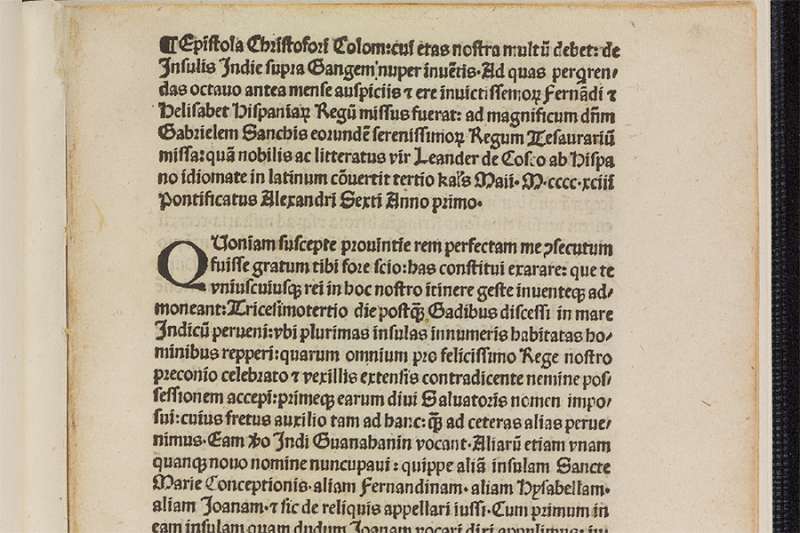After spending more than a decade in a private collection in Atlanta, a copy of a 1493 letter written by Christopher Columbus about his experience in America has been returned to its rightful place in the Vatican library.
Columbus penned the letter to Spanish King Ferdinand and Queen Isabella in 1493 after returning from his voyage to America, describing what he saw during his travels.
The “Columbus Letter,” unofficially titled “Letter about the Recently Discovered Islands,” was then translated and manually printed into Latin, and several copies were distributed throughout Europe. Around 80 authentic copies still exist today.
One of the oldest copies of the 8-page letter, written in small, fine print, was given to the Vatican in 1921 as part of the “De Rossi Collection,” which consisted of rare books and manuscripts given to the Vatican at the request of bibliophile Giovanni Francesco Rossi upon his death in 1854.
At some point, though it is not known exactly when, the letter was stolen. It was not until 2011 that a rare book and manuscript expert became aware that the copy in the Vatican Library collection was a forgery after closely examining details in the stitching, chain lines and page size.
The expert then contacted the U.S. Department of Homeland Security and Homeland Security Investigations about the possible theft.
Vatican officials were informed, and the forged letter was examined by more experts, including specialists from Princeton University, who confirmed that the letter was a fake.
The original copy of the Vatican's letter was eventually traced back to David Parsons, an actuary from Atlanta, who had purchased it for $875,000 from a rare book dealer in New York City in 2004, unaware that it had been stolen from the Vatican.
In 2013 Parsons sent his letter to the expert who originally caught the forgery, and after closely examining it, the expert found it to be authentic.
It was confirmed in 2016 that the “Columbus Letter” Parsons owned had been sold to the New York book dealer he bought it from by notorious Italian book thief, Marino Massimo De Caro, who is currently serving a 7-year sentence in Italy for the theft of roughly 4,000 ancient books and manuscripts throughout Italy.
After further comparative analysis was done on both the original letter and the forgery, it was confirmed in April 2017 that Parsons' letter had in fact been stolen from the Vatican Library, and that the theft had to have taken place sometime before 2004.
In August of that year, investigators contacted David Parsons' widow, Mary Parsons, and presented her with evidence of the theft and forgery. She agreed to part with the letter, renouncing all rights, title and interest, so that it could be returned to its original home in the Vatican Library.
The letter formally exchanged hands June 14, when U.S. Ambassador to the Holy See Callista Gingrich presented it to Vatican Archivist and Librarian, Archbishop Jean-Louis Bruguès, O.P. and the Library’s Prefect, Bishop Cesare Pasini, inside the Vatican Library.
During the hand-off, Gingrich called the letter “a priceless piece of cultural history,” and said she was honored to return the letter to “its rightful owner.”
She noted that U.S. Homeland Security Investigations (HSI) agents since 2007 have returned more than 11,000 artifacts and pieces of art from over 30 countries as part of an ongoing investigation into the illegal sale of stolen books and manuscripts.
To date, Gingrich said, HSI has repatriated both paintings and manuscripts to Austria, Italy, France, Germany and Poland, among others, and have recovered ancient artifacts from different regions, including Europe, South America, Asia and the Middle East.
In addition to the letter recovered from Parsons, HSI has recovered and returned two other Columbus Letters as part of their ongoing investigation into the sale of stolen books and manuscripts. The two additional Columbus Letters that were confiscated have been returned to the Riccardiana Library in Florence, and the Library of Catalonia in Barcelona.
As a gesture of gratitude to Mrs. Parsons for agreeing to part with her late husband's treasured “Columbus Letter,” the U.S. Embassy earlier this week hand-delivered a personal note from Mrs. Parsons to the pope.
In remarks during the repatriation ceremony, Archbishop Bruguès voiced gratitude to all involved in recovering the letter, which he said is “a priceless artifact of cultural history which today has found its way back to its home.”
He said the library was “surprised” to find out their copy was a fake, and noted that while it is still unknown when the original letter was taken, the technique used in the forgery, called “stereotyping,” was a common during the late 19th and early 20th centuries and reproduces not only the visual characteristics of the original, but also the tactile characteristics.
“We are extremely grateful to be able to reinsert this volume in its rightful place in De Rossi's collection,” he said, adding that the letter “will remain at the disposal of researchers who come from around the world to study the collections of the Vatican Library.”

